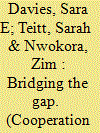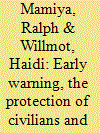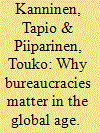|
|
|
Sort Order |
|
|
|
Items / Page
|
|
|
|
|
|
|
| Srl | Item |
| 1 |
ID:
139840


|
|
|
|
|
| Summary/Abstract |
Women, Peace and Security (WPS) scholars and practitioners have expressed reservations about the Responsibility to Protect (R2P) principle because of its popular use as a synonym for armed humanitarian intervention. On the other hand, R2P’s early failure to engage with and advance WPS efforts such as United Nations Security Council (UNSC) resolution 1325 (2000) has seen the perpetuation of limited roles ascribed to women in implementing the R2P principle. As a result, there has been a knowledge and practice gap between the R2P and WPS agendas, despite the fact that their advocates share common goals in relation to the prevention of atrocities and protection of populations. In this article we propose to examine just one of the potential avenues for aligning the WPS agenda and R2P principle in a way that is beneficial to both and strengthens the pursuit of a shared goal – prevention. We argue that the development and inclusion of gender-specific indicators – particularly economic, social and political discriminatory practices against women – has the potential to improve the capacity of early warning frameworks to forecast future mass atrocities.
|
|
|
|
|
|
|
|
|
|
|
|
|
|
|
|
| 2 |
ID:
120225


|
|
|
|
|
| Publication |
2013.
|
| Summary/Abstract |
This commentary traces the increasing importance of early warning in United Nations (UN) peacekeeping, an emphasis that has emerged in connection with the evolution of protection of civilians mandates in UN peacekeeping missions. It examines the current and emerging practice of early warning in UN peacekeeping as well as the challenges faced, drawing on case studies from the UN missions in South Sudan and the Democratic Republic of the Congo. The authors also propose a set of basic principles upon which early warning in UN peacekeeping operations might be approached in the future.
|
|
|
|
|
|
|
|
|
|
|
|
|
|
|
|
| 3 |
ID:
193849


|
|
|
|
|
| Summary/Abstract |
While the normative development of the UN’s focus on protection of civilians is well covered, there is little research on how more than two decades of translating the norm into practice has led to the development of an entire ecosystem of early warning tools across the UN system. Most of these tools have been created at the field level, and UN Member States have neither played a role in pushing for these tools nor in helping to develop them. This article makes two contributions. Empirically, the article maps the ecosystem of early warning tools for protection of civilians in UN peace operations. Second, drawing on practice theory, the article reflects on the origin of these tools and argues that bottom-up norm implementation practices in international organizations amount to norm fixations—collectively describing what a norm is and how it should be implemented in practice.
|
|
|
|
|
|
|
|
|
|
|
|
|
|
|
|
| 4 |
ID:
147560


|
|
|
|
|
| Summary/Abstract |
For just war doctrine to apply, the last resort requirement to exhaust all measures short-of-war must be fulfilled. Because of research and policy developments in the last fifteen years, the international community is now equipped with a richer understanding of how wars and atrocities evolve through time, improved precision about trigger points and risk factors that may accelerate that evolution, growing consensus on what prevention and mitigation steps to look for in that process, and new technologies for ascertaining these steps in order to intervene when mitigating action might deflect the escalation. It is thus argued that the responsibility of the international community to intervene in a timely and appropriate fashion has become increasingly clear and inescapable. It is further argued that the alert engagement of civil society in crafting this body of research and policy places a heavy public burden on government leaders to demonstrate that indeed all measures short-of-war have been exhausted. We now have at our collective disposal many more measures to deploy and many more witnesses to raise the alarm. Accordingly, the threshold for declaring that last resort has been reached has now become much higher.
|
|
|
|
|
|
|
|
|
|
|
|
|
|
|
|
| 5 |
ID:
119957


|
|
|
|
|
| Publication |
2013.
|
| Summary/Abstract |
The primary objective of this article is to advance the development of early warning of intrastate conflict by combining country-level structural and events data in a logistic regression model calibrated and validated using split-sample cases. Intrastate conflict is defined by the occurrence of one or more highly destabilizing events collectively termed a crisis of interest (COI). Two separate two-year periods between 1990 and 2005 were examined in twenty-five globally dispersed countries. COIs occurred in about 6 percent of all the half-monthly periods examined. While model accuracy (total correct predictions of COI and non-COI) usually exceeded 90 percent, the model did not generate sufficiently high and consistent precision (correct number of COI over total predicted) and recall (correct number of COI over total observed) for practical use.
|
|
|
|
|
|
|
|
|
|
|
|
|
|
|
|
| 6 |
ID:
120219


|
|
|
|
|
| Publication |
2013.
|
| Summary/Abstract |
This article examines the state of the art of early warning in Africa. It looks at the definitions of early warning, considers the historical evolution of conflict early warning systems, and takes a critical look at the debate about the link or the gap between early warning and early action. To this end, it tries to answer some important questions, particularly in relation to the purpose of early warning systems (EWSs) and their limitations so as to ensure that EWSs and early warning analysts are taken for what they are, and not criticised for what they are not or cannot do. In essence, it underscores the fact that the field of conflict early warning is not a fortune-telling business; an industry aimed at predicting socio-political events. The field and its different actors and mechanisms typically serve various purposes and rely on networks and open sources as well as cooperation. At times, some actions are indeed taken and potential conflicts prevented, but these actions do not come to the attention of outside observers precisely because nothing happened. It acknowledges, however, that the field can still learn from past experiences and improve on its delivery, at the level of both analysis and the ensuing action.
|
|
|
|
|
|
|
|
|
|
|
|
|
|
|
|
| 7 |
ID:
120224


|
|
|
|
|
| Publication |
2013.
|
| Summary/Abstract |
In June 2000, the Conference of Heads of State and Government of the Economic Community of Central African States (ECCAS) adopted the Protocol on the establishment of the Peace and Security Council for Central Africa (COPAX), with its two technical structures, namely the Central African Multinational Force (FOMAC) and the Central African Early Warning Mechanism (MARAC). MARAC is tasked with collecting and analysing data for the early detection and prevention of conflicts and crises. It currently consists of the Central Structure located at the ECCAS Executive Secretariat in Libreville (Gabon) and 31 Decentralised Correspondents spread throughout the ten member states of ECCAS. This article assesses the performance of MARAC in the light of its assigned objectives. Bearing in mind the peace and security challenges facing the central African sub-region, the central argument of this article is that while the establishment of MARAC is commendable, it flowed more from the logic and context of the establishment of similar mechanisms on the African continent during the same period than from any displayed capacity and/or readiness on the part of ECCAS to implement the recommendations due to emanate from such a structure.
|
|
|
|
|
|
|
|
|
|
|
|
|
|
|
|
| 8 |
ID:
129832


|
|
|
|
|
| Publication |
2014.
|
| Summary/Abstract |
This article will challenge the conventional wisdom according to which international bureaucracies are unviable and undesirable in the age of globalisation. The relevance and powers of today's international bureaucracies can best be understood by reference to the model of the 'network logic of globalisation' rather than Max Weber's classic theory alone. Bureaucracies are undergoing a transformation from the rigid and hierarchical institutions of Weber's time to more network-oriented and delayered post-Weberian entities. On occasion, these post-Weberian structures allow middle-level officials in international organisations to wield considerable new bureaucratic powers. The case study of this article draws upon empirical evidence on the drafting and implementation of An Agenda for Peace (1992) by UN Secretariat officials and its contributions to the United Nations early warning and conflict prevention mechanism. The network-oriented structures and approaches have started to permeate the UN Organisation in two ways: First, the United Nations operates more and more through interdepartmental and interagency teams. This trend was evident already in the drafting and implementation processes of the Agenda. Second, the United Nations is reaching out to academic and civil society networks. The start of these two transformations of the UN bureaucracy is related to globalisation and can be seen already in action in the early 1990s when the Agenda was drafted.
|
|
|
|
|
|
|
|
|
|
|
|
|
|
|
|
|
|
|
|
|